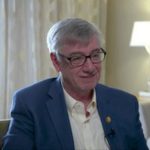What is vestibular rehabilitation?
Description
Vestibular rehabilitation is a specialized form of physical therapy and consists of exercises used to treat vestibular disorder symptoms, such as dizziness, vertigo, vision, and balance.
Transcript
“Vestibular rehabilitation can be very helpful for some patients, and I usually have my patients go through vestibular rehabilitation exercises. It's usually done by a physical therapist, or a therapist who specializes in vestibular therapy, and there are exercises that the therapist teaches the patient how to do, which they can then do at home. Sometimes the exercises are, we call them, habituation exercises. Habituation means the more you do it, the less severe the symptom becomes. They kind of provoke the symptom in a light and gentle way repeatedly, so that the symptom dissipates over time. Now you may think, ‘Why would that happen?’ The brain has amazing capacity to adapt to either an injury, or to abnormal function of a certain pathway. In vestibular migraine, we don't think that the vestibular pathway is injured necessarily, but it's not functioning properly. This is in an effort to try to get other parts of the brain to adapt or compensate for that.
“The other thing we do is what we call gaze stabilization. We have a patient, for example, that I will look at you and I will keep doing this with my head [turning from side to side], or I will keep doing this with my head [moving up and down]. Spooky right now, but that can help compensate for that as well.
“Then, sometimes, we do balance training. There are three things that may stabilize us where we can keep our equilibrium. It's what we see. It's the sensation in our extremities, and it's the vestibular system. If one system is not working properly, we focus on vision and we focus on the sensory system in the limbs. Sometimes, we can do balance training for patients whose dizziness is there all the time and they sort of feel like they're unsteady, or they're unbalanced.”
Discussion
Vestibular rehabilitation is a specialized form of physical therapy that consists of exercises used to treat the symptoms of vestibular disorders. It is thought that the pathways of the vestibular system are not functioning properly, so the exercises are an attempt to help the other parts of the brain compensate for this malfunction. Exercises are taught that the patient can do at home to help with dizziness, vertigo, vision, balance, and any other symptom associated with vestibular disorders such as vestibular migraine. Gaze stabilization exercises are used to help with vision problems, and balance training is used to help patients to better maintain their equilibrium and balance.
This is a short segment of a full video interview. View the full version by upgrading to an Access Pass bundle! Get FREE access to 8 expert interviews from Day 1 and Day 2 when you register today!

David Dodick, MD
Professor (Emeritus)
Mayo Clinic, Arizona
David Dodick, M.D., FAAN, is a professor of neurology at the Mayo Clinic College of Medicine and Science in Scottsdale, Arizona. He is the director of the headache program and the sports neurology and concussion program at Mayo Clinic in Arizona. He is an adjunct professor in the department of neurosciences, Norwegian University of Science and Technology. Dr. Dodick is board certified by the Royal College of Physicians and Surgeons of Canada and the American Board of Psychiatry and Neurology (ABPN). He also holds United Council for Neurologic Subspecialties certification in headache medicine and ABPN certification in vascular neurology.
Dr. Dodick has authored more than 380 peer-reviewed publications and authored/edited 10 books. He is the chair of the American Migraine Foundation, chair of the American Academy of Neurology (AAN) Annual Program Concussion Committee, co-director of the American Registry of Migraine Research, chair of the International Registry for Migraine Research, chair of the International Headache Society Global Patient Advocacy Coalition, co-director of the Annual AAN Sports Concussion Conference, president-elect of the International Concussion Society, immediate past-president of the International Headache Society, former editor-in-chief of Cephalalgia, and past-president of the American Headache Society.



